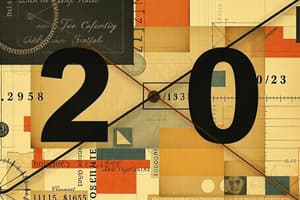Podcast
Questions and Answers
What is the tenths place in the number 6.732?
What is the tenths place in the number 6.732?
- 7
- 6
- 2
- 3 (correct)
How many decimal places are there in the number 9.87654?
How many decimal places are there in the number 9.87654?
- 7
- 4
- 5 (correct)
- 6
What is the result of adding 5.67 and 8.912?
What is the result of adding 5.67 and 8.912?
- 13.582
- 14.004
- 14.582 (correct)
- 14.32
In the expression $7.5 - 4.87$, what is the correct result?
In the expression $7.5 - 4.87$, what is the correct result?
If you multiply 6.25 by 4, what will be the result?
If you multiply 6.25 by 4, what will be the result?
When multiplying decimals, what is the first step?
When multiplying decimals, what is the first step?
What is the result of multiplying 3.1415 and 2.9804?
What is the result of multiplying 3.1415 and 2.9804?
When dividing decimals, what should be done first?
When dividing decimals, what should be done first?
What is the result of dividing 3.1415 by 2.9804?
What is the result of dividing 3.1415 by 2.9804?
What is essential for accurate calculations and problem-solving involving decimals?
What is essential for accurate calculations and problem-solving involving decimals?
Flashcards are hidden until you start studying
Study Notes
Decimals: A Comprehensive Guide
Decimals are a system of representing numbers that have a decimal point, which is a small dot placed between two digits. This allows for the representation of numbers that are not whole. decimal place value, adding and subtracting decimals, and multiplying and dividing decimals are essential operations in mathematics. This article will discuss these subtopics in detail.
Decimal Place Value
Decimal place value is the position of the decimal point in a number. The first digit to the left of the decimal point represents the ones place, the second digit represents the tenths place, and so on. For example, in the number 3.1415, the 3 is in the ones place, the 1 is in the tenths place, and the 5 is in the hundredths place.
Adding and Subtracting Decimals
To add or subtract decimals, follow these steps:
- Line up the decimal points vertically. If the numbers have different numbers of decimal places, fill in zeros as needed.
- Add or subtract the numbers as if they were whole numbers.
- Place the decimal point in the sum or difference so that it lines up vertically with the numbers added or subtracted.
For example, to add 3.1415 and 2.9804:
- Line up the decimal points: 3.1415 2.9804
- Fill in zeros as needed: 3.1415 2.9804
- Add the numbers as if they were whole numbers: 3 + 2 = 5
- Place the decimal point in the sum: 5.
The result is 5.1415.
Multiplying Decimals
To multiply decimals, follow these steps:
- Convert the decimals to fractions.
- Multiply the fractions as if they were whole numbers.
- Convert the result back to a decimal.
For example, to multiply 3.1415 and 2.9804:
- Convert the decimals to fractions: $$\frac{3.1}{10} \times \frac{2.98}{10}$$
- Multiply the fractions as if they were whole numbers: $$\frac{3.1 \times 2.98}{10 \times 10} = \frac{8.91}{100}$$
- Convert the result back to a decimal: $$8.91 \times \frac{1}{10} = 0.891$$
The result is 0.891.
Dividing Decimals
To divide decimals, follow these steps:
- Convert the divisor to a whole number by moving the decimal point as many places to the left as necessary.
- Divide the dividend by the whole number.
- Convert the result back to a decimal.
For example, to divide 3.1415 by 2.9804:
- Convert the divisor to a whole number: $$2.98 \times 10^2 = 298$$
- Divide the dividend by the whole number: $$\frac{3.1415}{298} \approx 0.1032$$
- Convert the result back to a decimal: $$0.1032 \times \frac{1}{10} = 0.01032$$
The result is 0.01032.
In conclusion, understanding and performing operations with decimals is essential for accurate calculations and problem-solving in various aspects of mathematics and real-life situations. By following the guidelines provided in this article, you can effectively add, subtract, multiply, and divide decimals.
Studying That Suits You
Use AI to generate personalized quizzes and flashcards to suit your learning preferences.



